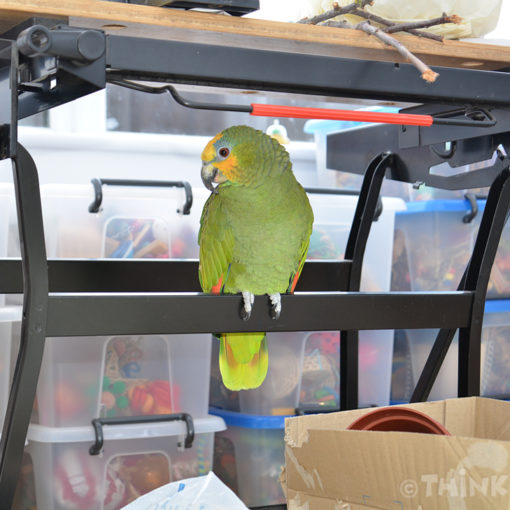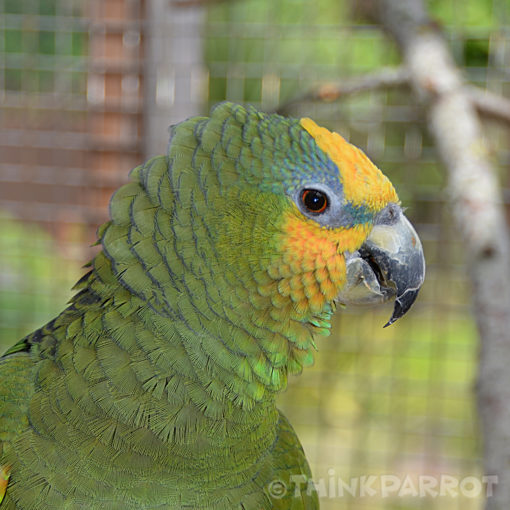This article was first published in Parrots Magazine January 2010 Issue 144. It was updated in April 2024.
Initially cautious, the shy Pionus parrot is often overlooked in favour of the larger more confident Amazon or the cuddly Cockatoo baby. At first glance the Pionus plumage too seems somewhat modest, especially when immature. Consequently these “wallflowers” are rarely an impulse buy.
So what attracted me? I wanted a parrot who was gentle, not too noisy and could look after himself whilst I was at work. I wasn’t quite prepared for what I actually got – a parrot with a huge personality, astounding intelligence, a big chatterbox and pretty wilful at times. A parrot so engaging I had to cut down my work hours to accommodate him. Meet Kobe the Blue-headed Pionus.
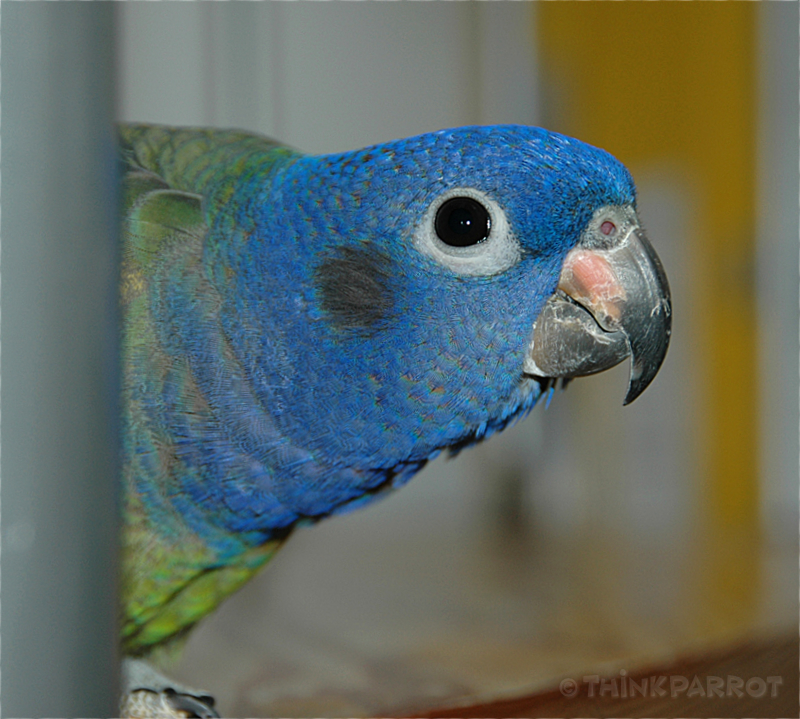
I was also astonished at his “modest” plumage. It isn’t until you see Pionus feathers under bright light that you notice how they literally shimmer with the most unexpected jewel colours. Flash photography captures this quality well.
Origins
Pionus originate from Central and South America, stretching from northern Mexico down into northern Argentina. Stocky, short tailed parrots they are instantly recognisable by their dark, doe eyes and triangular splash of red on the vent – indeed, they used to be called “Red Vented Parrots”. Because they are relatively new to aviculture their life expectancy is unknown, although it is thought to be about 30 – 40 years with good care.
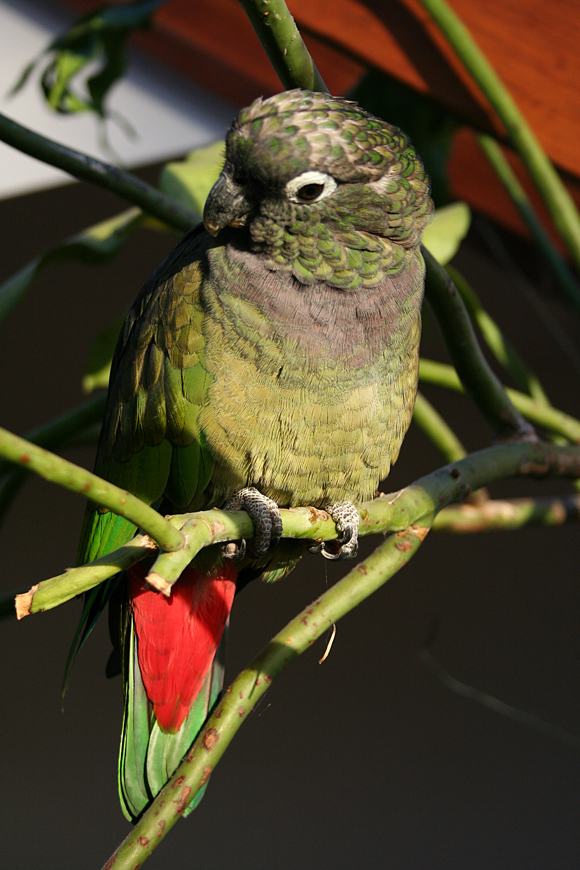
The Species
There are eight species, two of which are rare in captivity. Maximilian’s, Blue-headed and White-capped are most available as pets in England. Bronze-winged are becoming more popular, and although Dusky are fairly available in the US they are not so common in the UK. The scarcer Coral-billed are predominantly in breeding programs in the US. The two species that have proven extremely difficult to manage in captivity are Plum-crowned (Pionus tumultuosus) and White-headed (Pionus seniloides). It is unknown when or whether these two will ever become available to the general public.
Of the pet Pionus, Maximilian’s and Coral-billed are the largest of the group at about 29cms long, with Blue-headed and Bronze-winged a close second at roughly 28cms long. These four weigh between 225 – 260gms. White-capped and Dusky are the smallest at about 24cms long, weighing between 185 – 220gms.
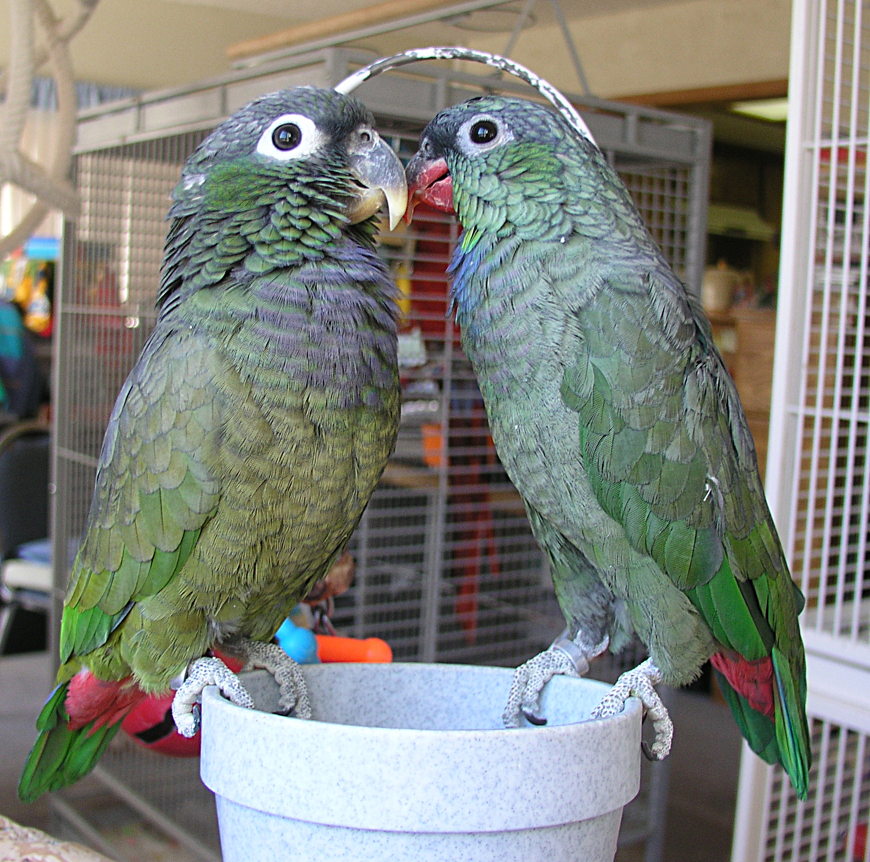
Characteristics
The first thing most people want to know are the differences in character between the species. However, for every trait that is said to be absolutely true of a specific species it is also absolutely false. Nobody can agree because it is too subjective. As Russ Shade, one of the current leading experts on Pionus, says, “what we concluded after years of observation is that there do not appear to be any consistently appearing species-specific behaviours in captive Pionus, with the possible exception of White-capped”, and I would add Dusky, mentioned later.
Pet Pionus are highly intelligent and inquisitive and love to interact with their humans. While content to watch as you go about your chores, they would much rather join in! These parrots thrive on attention. Although hands-on, adults are not cuddly in the way a Cockatoo or Conure might be. In a quiet moment they are happy to sit on or near you and solicit head scratches. They tend to bond strongly with one person, but are often tolerant of other members of the household.
Roger Sweeney (Curator at Loro Parque 1994 -1998) describes the pet Pionus as similar in personality to the pet Amazon but “more consistent and less aggressive”. However, like most parrots, Pionus still have their “aggressive” moments to a greater or lesser degree, especially in the breeding season.

White-capped and Dusky have a reputation of being headstrong or feisty, particularly adult males. Yet their caregivers wouldn’t have these larger than life characters any other way.
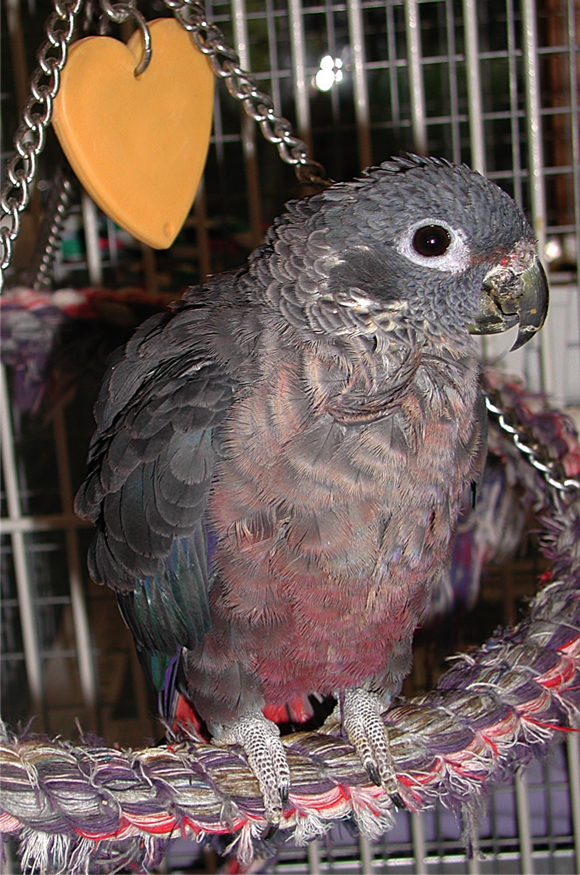
Female Pionus are often, but not always, more gentle but this doesn’t mean that males don’t also make excellent pets. It depends on what you are looking for in a companion. There is never a dull moment with Kobe my Blue-headed male. He plays hard and loves hard. Pionus, however, are not as high energy as Caiques or Conures and thankfully let you lie in on weekends.
It is all very well describing general characteristics, but it is also important to remember that each bird is an individual. Pionus work hard to fit in with their humans, who in turn report time and again how perfect their bird is for them.
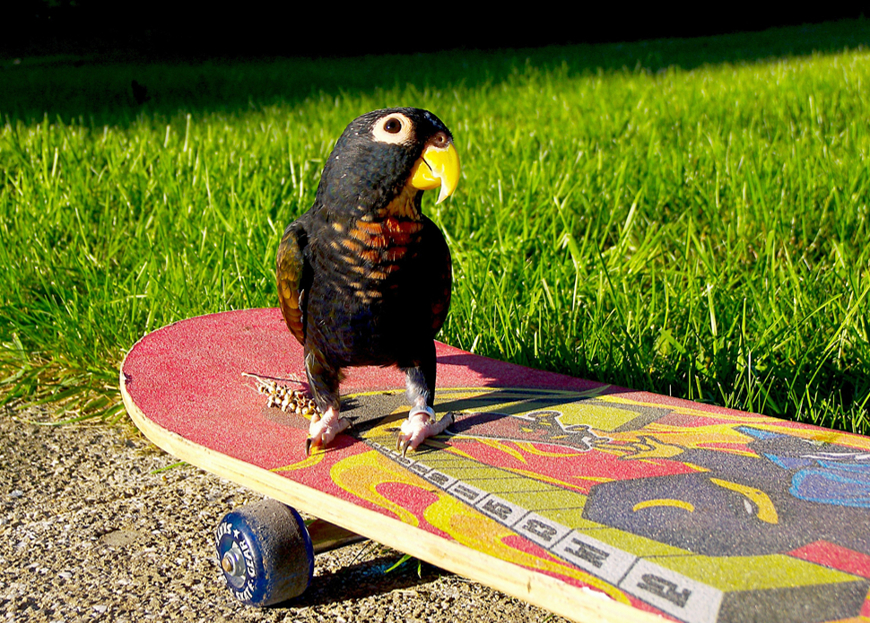
Noise
Most could be described as quieter than other parrots. But they can easily out-scream the vacuum cleaner if the mood takes them. Often there is a raucous dawn and evening chorus when the bird expresses a joy of being alive, which is even more fun when their human joins in too. However, noise levels also depend on the household. A loud or multiple bird household often produces a noisier bird regardless of genus.
Talking
The Pionus voice is a little raspy compared to the absolute accuracy of a Grey, still some achieve a vocabulary to be proud of. Ray Dorge, who used to breed Maximilian’s in Canada says that males are usually better at talking and females better at tricks. This seems to be true, with male Maximilian’s and Blue-headed top of the talking league. However, some choose not to talk at all preferring to imitate whistles and other sounds.
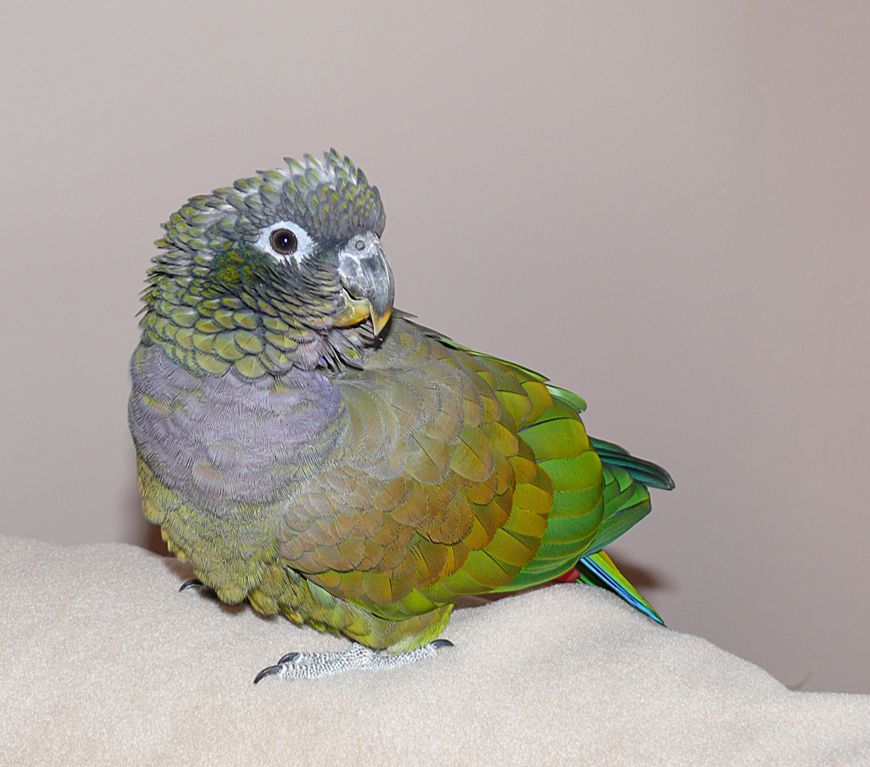
Body Language
The Pionus body language is similar to the Amazon, and like the Amazon it is consistent. It is important to become familiar with and respect it. Ignoring it may result in the parrot biting as a last resort to make himself understood, and habitual biting is difficult to correct. They in turn are masters at reading their human’s body language. If you are feeling angry or excited they will mirror it, so sometimes it is best to take a minute to lower your energy before interacting with these little “mind readers”.
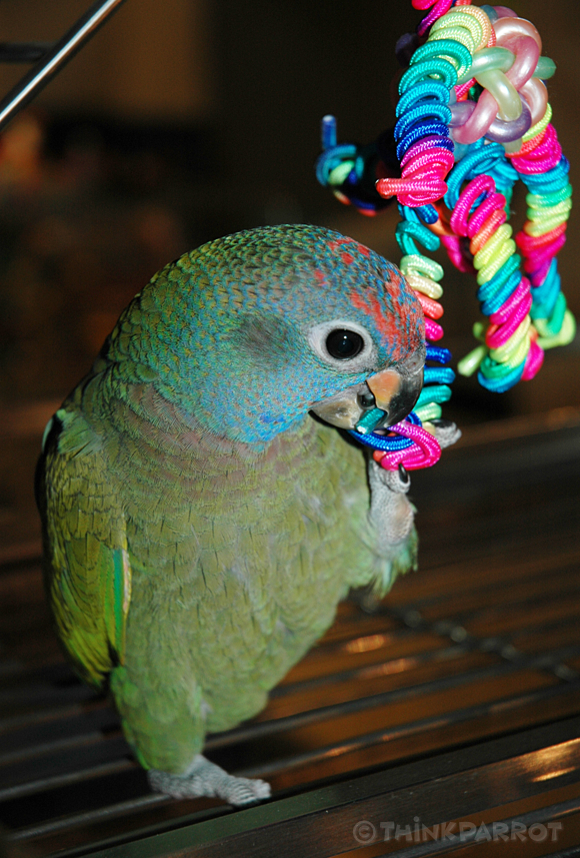
Puberty and Hormones
From about 18 months to 2 years old, the cuddly Pionus baby begins to have another agenda. In males there may be increased cage defensiveness, more vocalization, searching for nesting places, and the famous Pionus strut! Sally Blanchard once said that male Pionus have larger testes than other parrots, for their overall size, which could account for their heightened sensitivity at this time. Females’ behaviour will also change but generally not as noticeably as the males. Females will also seek out nesting places, make unusual vocalizations such as clucking and/or loud repetitive honking, and some will produce infertile eggs. The intensity might lessen after a few cycles, but it might not, it depends on the individual. All you can do during this period is remain consistent in your affections for your little ball of hormones, be ultra observant of his or her body language and try to discourage nesting by providing no dark hidey holes.
Pionus Strut
A predominantly male behaviour, the strut is a way of warning you to steer clear of them or their territory, it can also be a display of excitability or nervousness – or all four! The bird lowers the head so that the body is parallel with the ground. He or she then marches slowly up and down, usually on or near their perceived territory, tail flared, head and body puffed, wings held stiffly slightly away from the body. Admire but don’t touch if you value your fingers!
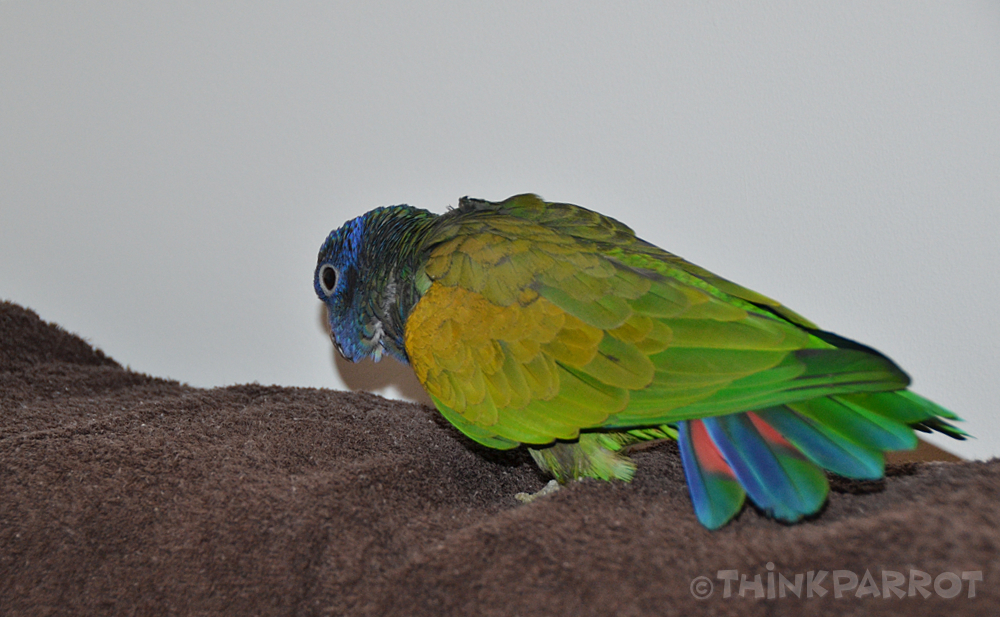
Wheeze
Another trait curious to the Pionus is wheezing when excited or stressed. Some people never hear their bird wheeze, then there are some like Kobe my Blue-headed who sounds like an asthmatic steam train when getting his goodnight head rub. It can sound quite alarming, but it is important to be aware of so that the bird doesn’t get mistakenly treated for a respiratory problem.
Freeze
A further response to stress or fear is freezing. There is nothing you can do to snap your Pionus out of it. You can only try gently removing the bird or the thing causing the fear.
Aroma
You can’t live with a Pionus and not notice the occasional aroma they emit seemingly from the head area. There is a theory by Dr. Donald Brightsmith of Duke University that the scent is to attract ants and termites in the wild. These insects help keep the nests clean as well as drive out predators. It appears that the different species of Pionus give off slightly different smells. From my own limited survey Blue-headed give off the sweetest aroma and Bronze-winged the muskiest with the other commonly kept species somewhere in between.
Dander
Pionus, like Amazons and some Macaws, have no preening gland (Uropygial gland) near the base of their tail so make use of feather dust to maintain their feathers. Still, they are far less dusty than the powder down birds, Greys, Cockatiels and Cockatoos, who do have the Uropygial gland, but whose down feathers crumble as a means of keeping themselves clean. Regular bathing helps keep the dander down and feathers in top condition.
Shower
For any Pionus unwilling to have a shower, switching on the vacuum cleaner is almost guaranteed to get them in the mood! The bird will flip upside down, wings and tail spread wide waiting to catch every drop of water. Some say that the noise of the vacuum cleaner is similar to that of a heavy shower in the rain forest and triggers an inbuilt reaction – so why doesn’t a real storm produce the same reaction? It’s a well kept Pionus mystery.
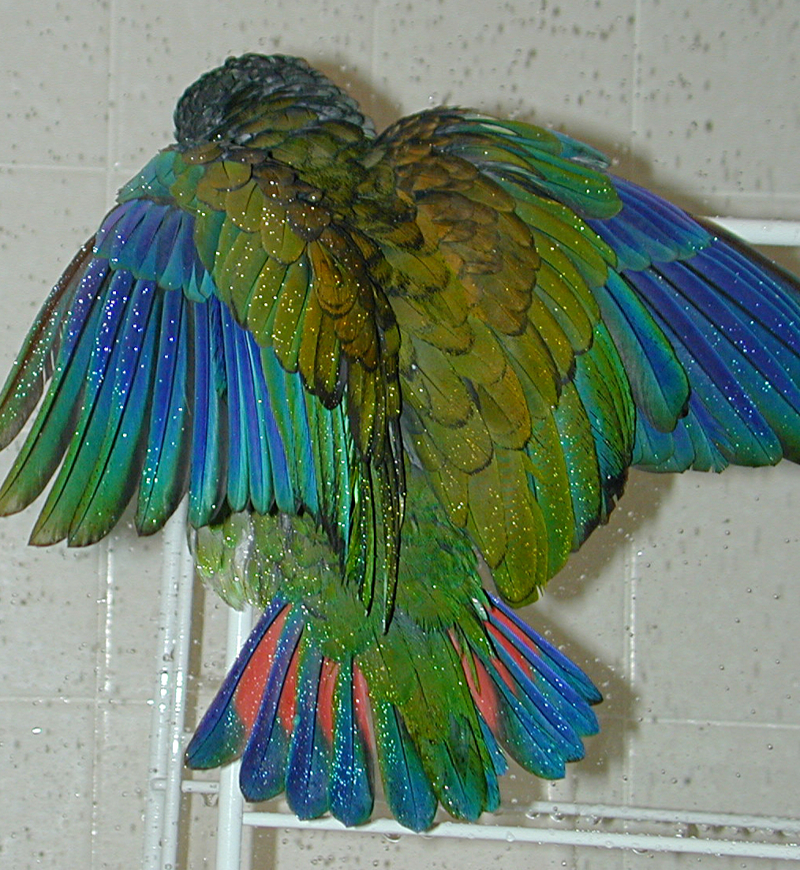
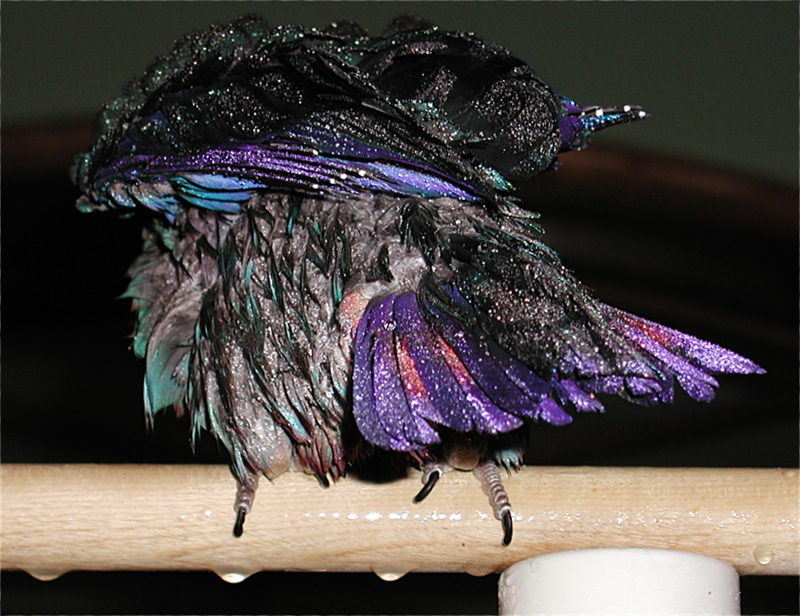
Housing and Toys
The bigger the better when it comes to the cage, but something in the region of 34” x 24” x 36” high (86cm x 61cm x 92cm) is a good size, with 1” bar spacing and ¾” spacing for smaller Pionus under 200gms. Feeders you can access from the outside of the cage are essential for these territorial parrots who don’t take kindly to intruders. Toys are important for any parrot and rotating them in and out of the cage keeps the inquisitive Pionus mind from getting bored. They love to chew soft wood, balsa and cork, and to explore the different textures that safe plastics offer. Foot toys are a favourite, as are hanging gyms or rope spirals – they love to play and hang upside down.

Clipped or Unclipped?
An emotive subject. Personally, I think it is a tragedy to take away a skill so fundamental to a bird’s identity for the sake of human convenience. It is important to at least let a young parrot fledge properly. As Greg Glendell stresses, “clipping any immature bird (under two years old) can impair the normal development of the bird’s heart and wing muscles and affect it for the rest of its life.” A growing number of people, including breeders, are choosing not to clip now.
Pionus are extremely strong fliers so even if a bird’s wings are clipped, escape is still very possible. Pionus have an unusual way of flying – they don’t fully extend their wings, but instead use half wing strokes. This builds powerful chest muscles which give the breast a rounded or full appearance, hence the name Pionus which means “fat parrot”.
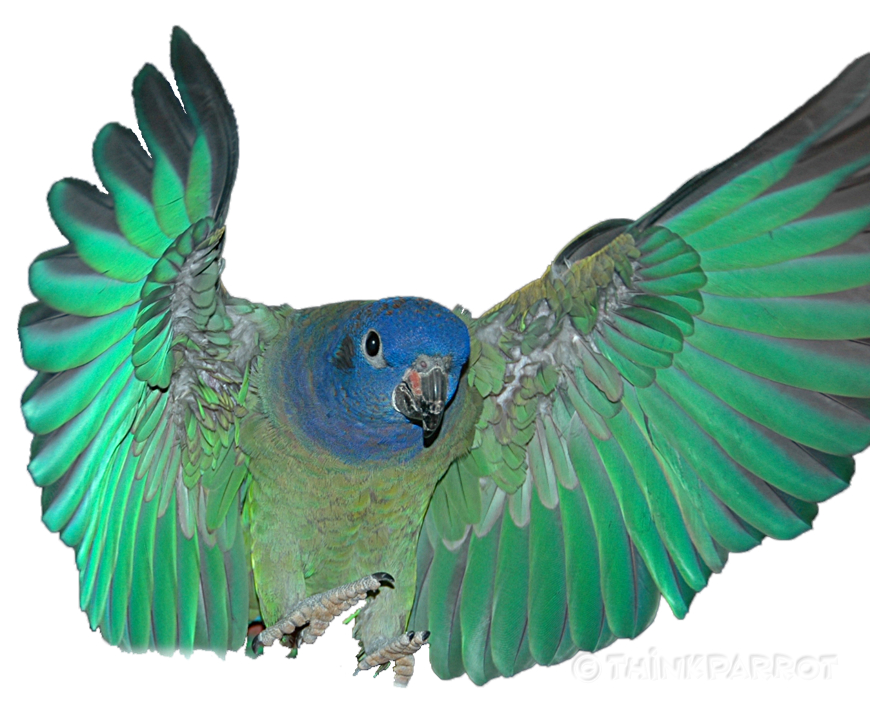
Diet
Like many other parrots, Pionus are most likely to be deficient in Vitamins A and D. Pionus seem to require high levels of Vitamin A. It is easy for a veterinarian to check whether the bird is receiving adequate amounts – the choanal papillae (small growths inside and at the back of the parrot’s mouth) should be pointed – if they are stunted or blunted, it is an indicator that the bird is Vitamin A deficient. Calcium is also important for Pionus, as unlike mammals parrots cannot store the mineral. However, before rushing to buy a calcium or Vitamin A supplement, the danger of overdosing is as harmful as being deficient. Too much calcium can harm the kidneys. It is always wiser to try to fulfil nutritional needs with natural foods, and to consult an avian veterinarian for any real concerns.
Just for interest since there is some discrepancy on the amount of protein Pionus should consume, using Dr Mauro Galetti’s 1993 paper on the “Diet of the Scaly-headed Parrot” (Maximilian’s Pionus) in a rainforest in south east Brazil, nutritional scientist, Dr Amy Zhao calculated on a dry matter basis, the amount of protein consumed by these wild Maximilian’s Pionus. Their intake works out to be an average of 15% protein which increases to approximately 20% in breeding (dry season) – that there would be no nutritional differences to other parrots common to that area.
Because our pet Pionus are way more sedentary than their wild counterparts (even the most active of birds), they cannot possibly consume the same calories or same quantities of food that wild Pionus do (flying, foraging, etc). This means our captive birds would not be able to get vitamins and minerals in the same quantities naturally present in the diet of the wild Pionus. Therefore to ensure they are getting enough nutrients, the best diet is one that is fresh (vegetables and fruit), supplemented by pellets, the better brands being Harrison’s or Roudybush.
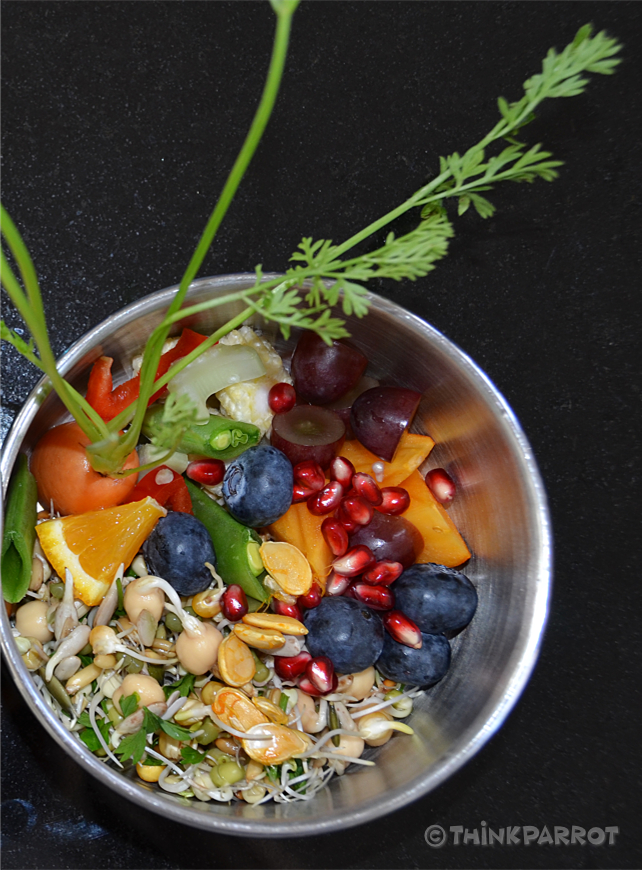
Vegetables and fruits can include, sugar snap peas, broccoli, squash, peppers, carrot, cabbage, kale, celery, corn, peas, chilli peppers, blueberries, grapes, pomegranate, cranberries, mango, papaya, nectarine, strawberries, raspberries, apple, fig, etc. (except avocado, rhubarb and star fruit, all of which are toxic). Some fruits and vegetables contain high levels of pesticides, especially grapes and cherries, so I prefer to feed organic where possible. Adding sprouted legumes, grains and seeds to the fresh bowl not only further increases the vitamin and mineral content but also provides essential enzymes. Favourite sprouted legumes and seeds can include, chickpeas, lentils, mung beans, sunflower, radish, etc. Some grains are better soaked like oat groats, whilst others like wheat, rye, kamut, etc. will sprout. All these are available from a good health food store.
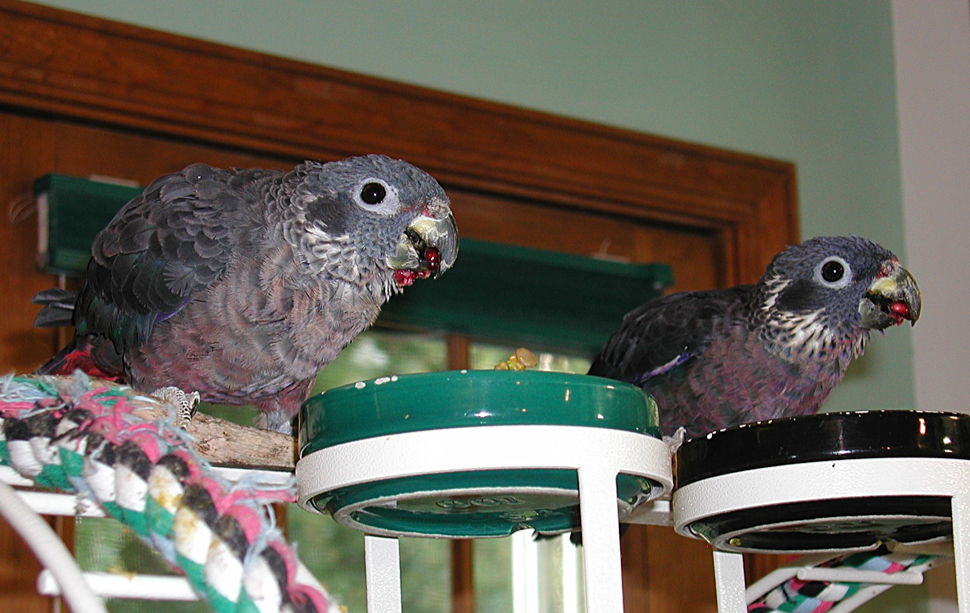
A mash made of cooked grains and legumes, at a ratio of 2:1 to provide a complete protein, given once a day is a good way of including vegetables a bird might not choose for himself. Cooked with beta carotene rich foods such as carrot and sweet potato and frozen in tiny containers, each portion can then be defrosted as needed. Before serving, finely chopped dark green vegetables like broccoli or kale can be mixed in. I also like to add a few drops of cider vinegar and a few drops of Omega-3 rich flaxseed oil. Legumes are a good source of calcium and phosphorus (phosphorus together with Vitamin D helps calcium absorption). The best source of Vitamin D is sunlight.
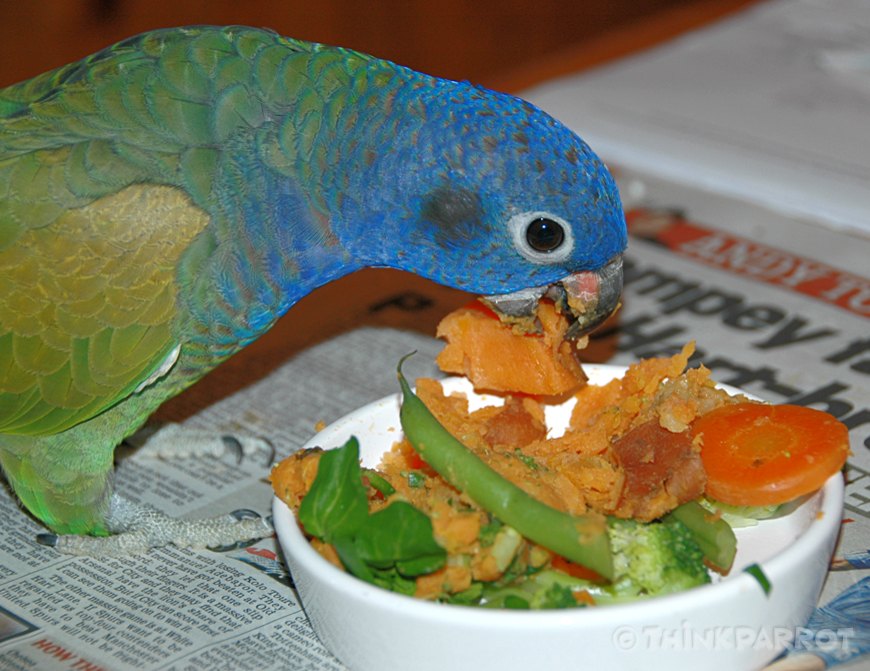
Treats such as nuts should be given sparingly since Pionus are prone to obesity when mature. The better nuts are almonds and walnuts, high in calcium and Omega oils respectively. Peanuts should be avoided as they are likely to harbour Aspergillis spores.
Disease
Obviously a good diet and cleanliness will lessen the chance of disease and regular check ups can help catch anything untoward early. However, Pionus may be susceptible to Aspergillosis.
Aspergillosis is a fungal disease that affects the respiratory system. Aspergillus spores are everywhere but prolific in moist, dirty areas. The spores can also be present in unshelled peanuts, unshelled pine nuts and badly stored seeds. Normal levels in the atmosphere don’t usually pose a threat to a healthy bird. However, if the bird is ill, or has a compromised immune system for any number of reasons including chronic malnutrition or stress, or has prolonged exposure to high levels, it can prove fatal. Vitamin A deficiency may or may not play a part, but this vitamin is certainly necessary for a healthy immune system and healthy mucus membranes. An interesting slant on the problem was highlighted by Chris Hall, Kobe’s ex avian vet, in that Aspergillosis can be exacerbated through the overuse of antibiotics and steroids which suppress the immune system. This scenario is more likely to occur if a vet has little knowledge of birds and treats them as he would a dog or cat.
Because Pionus originate from the high altitude, mountainous areas of Central and South America where the air is thin and clean, it is thought that bringing them down to lower altitudes could also be a contributor to Aspergillosis. Russ Shade begs to differ stating that he has never lost a bird through the disease. However, Plum-crowned are notoriously difficult to keep in captive situations and their natural habitat is in the highest altitude of them all at 3000+ metres above sea level. Whatever the reason, it is best to take preventative measures.
The Pet Pionus
Although very much individuals, Pionus all have the same talent for firmly capturing their humans’ hearts. Entertaining, intelligent, confident, bold, curious, loving, loyal, independent, territorial, feisty, laid back, quiet, funny, beautiful, are just some of the adjectives people have used to describe their pet Pionus. Not one said wallflower!
The Pionus Family
Maximilian’s (Pionus maxamiliani).
Sometimes called the Scaly-headed Parrot, the dark green head feathers are scalloped in grey giving an attractive scaly appearance. The throat and upper chest are a mauvy purple and the body different shades of green. The back and wings range from dark to light olive brown. The beak can vary but is usually yellow with dark grey towards the base of the upper mandible. The eye rings are white to light grey.
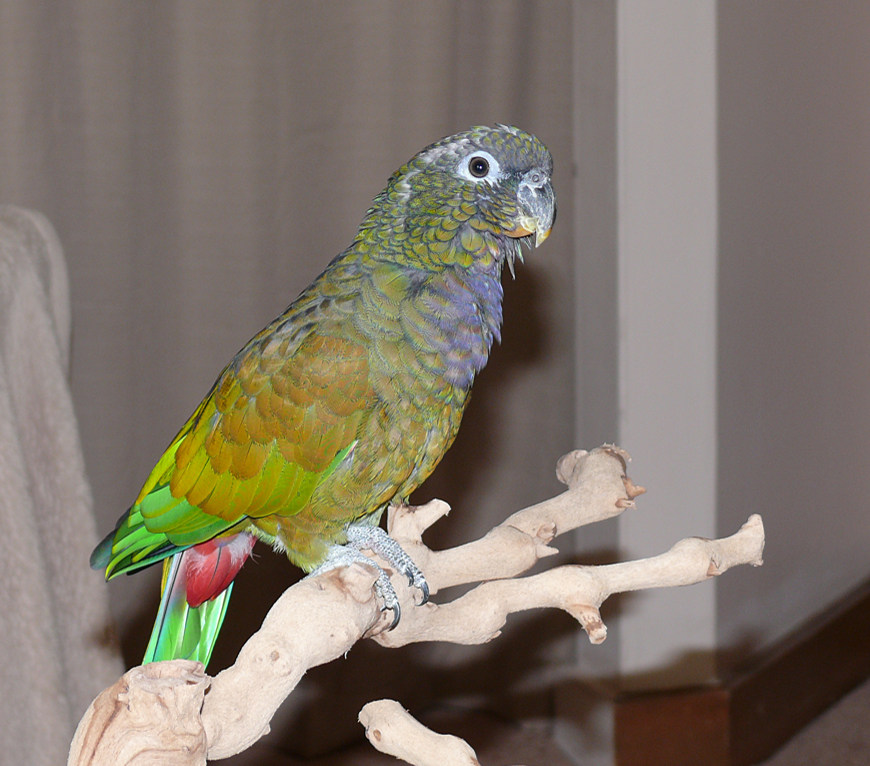
Blue-headed (Pionus menstruus).
At about one year the head and upper chest become deep cobalt blue, and the beak turns blackish with a pink patch either side of the upper mandible. The body and wings are many shades of green. The eye rings are grey.
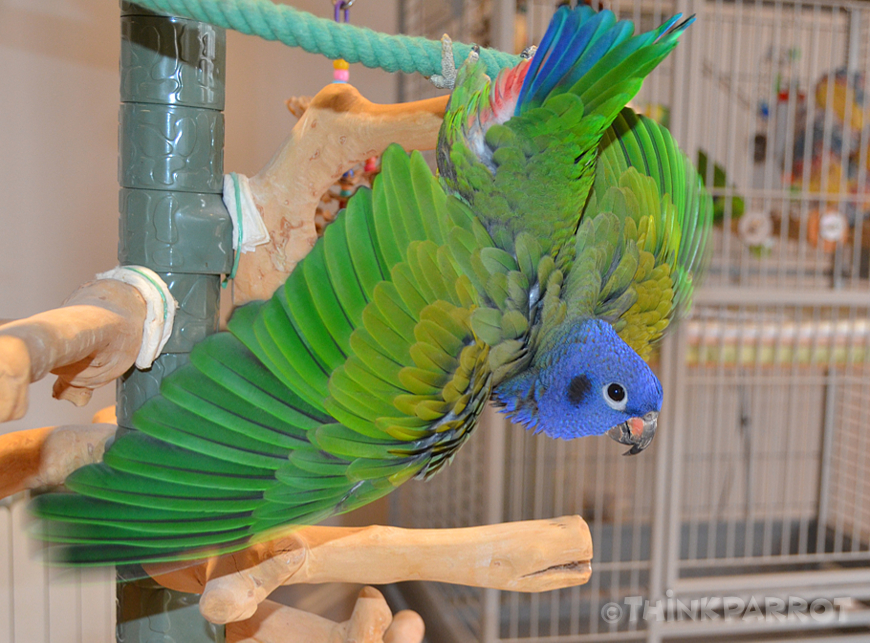
White-capped (Pionus senilis).
The head feathers are mainly green edged with blue. The white cap on the forehead and crown is complete at about one year. The body is mostly green and the chest olive brown edged with blue. The upper wings are greenish brown. The beak is yellowy and the eye rings vary from whitish pink to orange.
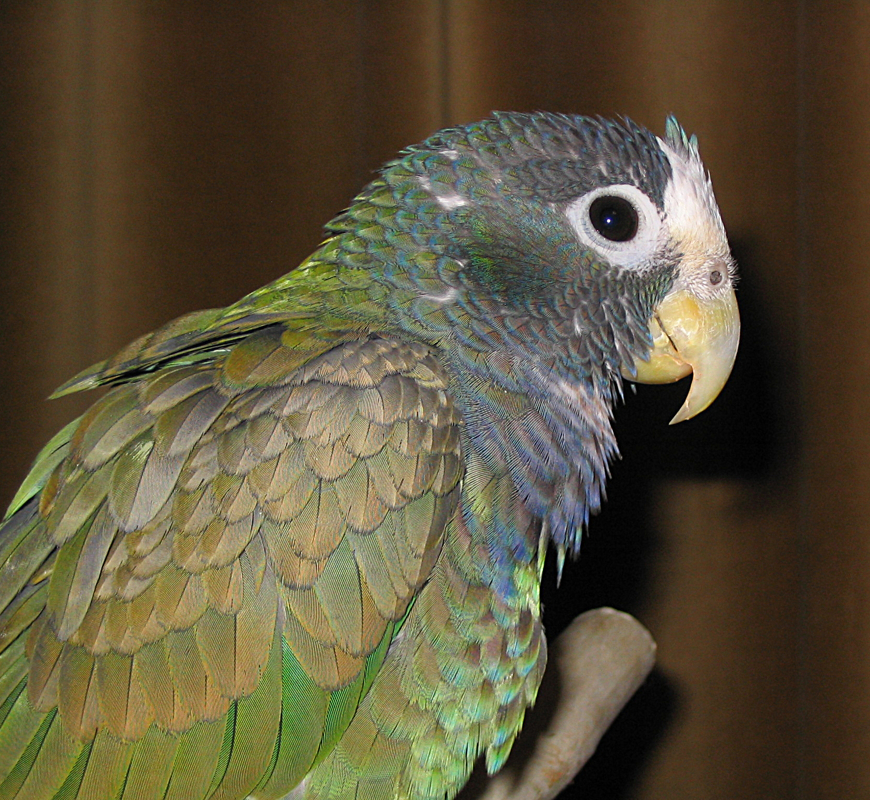
Bronze-winged (Pionus chalcopterus).
The main overall colour is a dark violet blue with pink at the throat. The upper wings are bronze and the flight feathers purple blue. The beak is yellow and the eye rings dull pink.
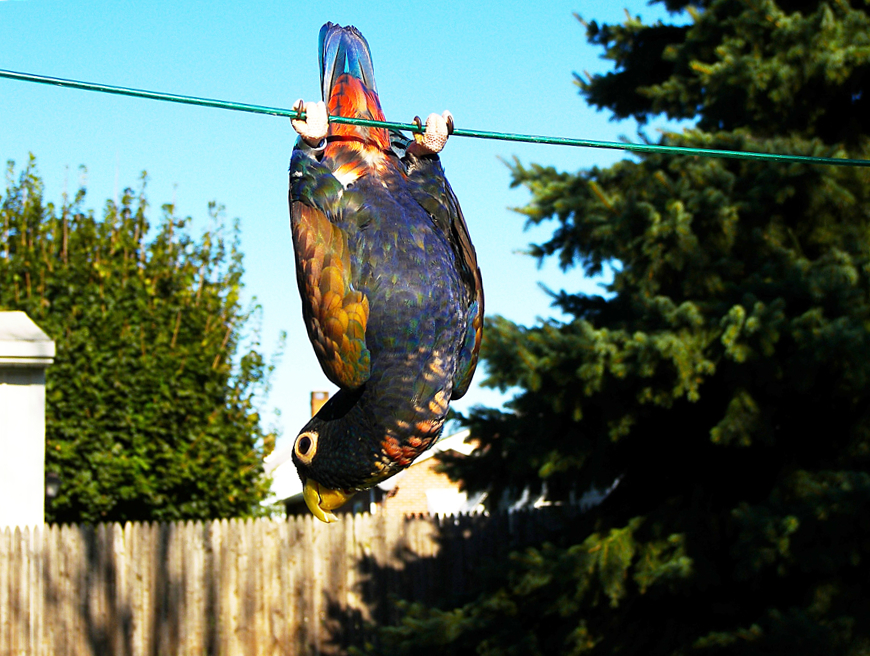
Dusky (Pionus fuscus).
The black and white markings on the slate blue head gives this species a hawk-like appearance. The chest is mauvy pink and wings a dark grey brown. The beak is blackish with yellow on the sides. The lores are red and the eye rings grey.
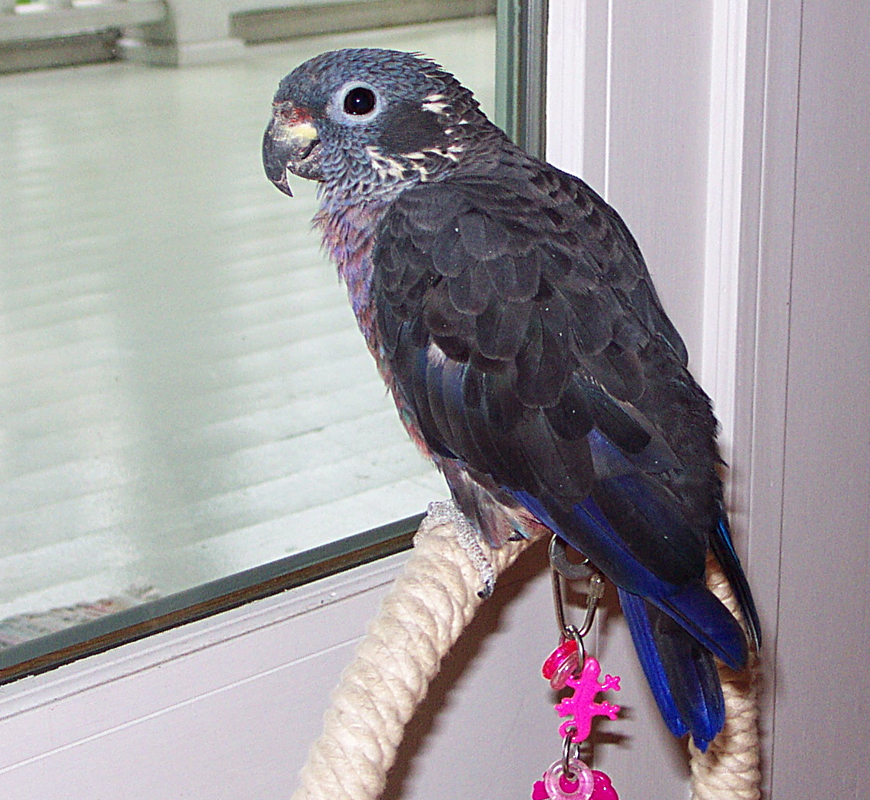
Coral-billed (Pionus sordidus).
The main overall colour is olive green with a silvery sheen. There is a purple blue band across the upper chest and neck area. The beak turns coral red at maturity and the eye rings are grey.
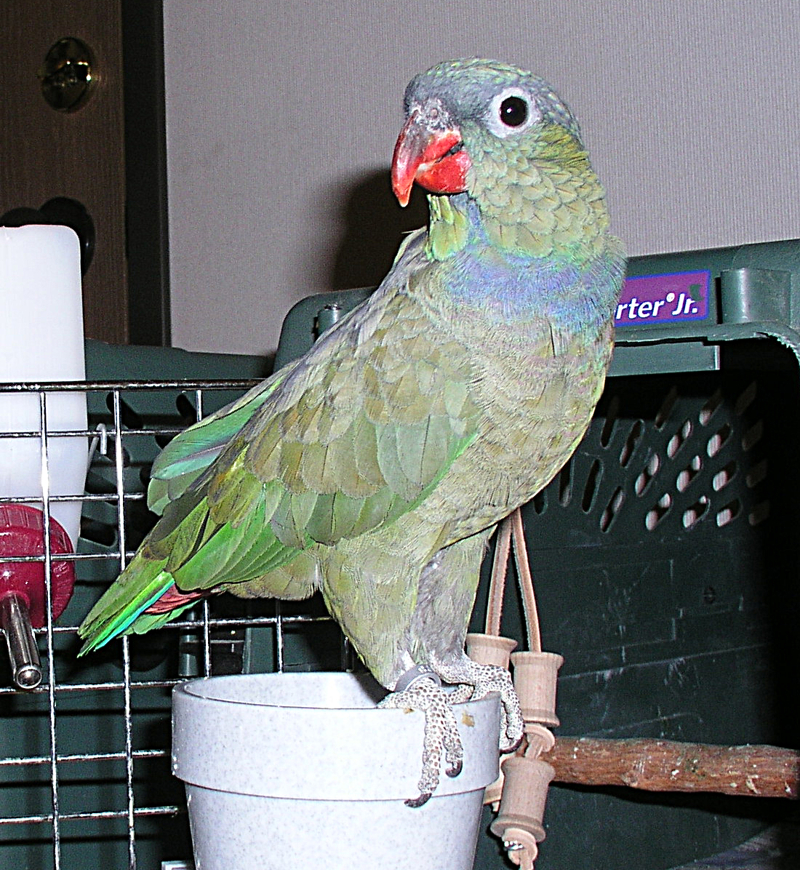
References and recommended reading / visiting
The Practical Pionus by Russ Shade available from www.the-practical-pionus.com
Pionus Parrots: a complete guide by Roger G. Sweeney
Greg Glendell’s consultancy can be found at www.greg-parrots.co.uk
Dr Amy Zhao https://www.thebudgieacademy.com/
Thank you to all those who sent photos for the article


